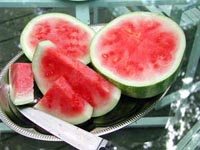Resource Library
Plant of the Week: Watermelon, Seedless
The University of Arkansas System Division of Agriculture does not promote, support or recommend plants featured in "Plant of the Week." Please consult your local Extension office for plants suitable for your region.
Plant of the Week
Seedless Watermelon
Latin: Citrullus lanatus "Seedless Triploids"

Summertime makes all of us watermelon lovers. A ripe, cold watermelon is hard to eat on a hot, sticky August day even though eating it with grace and dignity requires relaxing a few of Emily Post’s most cherished rules. Most watermelon is eaten outside where the rivulets of juice on your chin and the whiz of black seeds past your ear can be conveniently ignored. But, in an attempt to housebreak watermelon, breeders now offer seedless watermelon.
Watermelon, Citrullus lanatus, is a member of the cucumber family that originated from the warm climes of tropical Africa. They have been popular as summer garden fare since the time of the Egyptians. Their origin was thought to be China until the 1860s when explorer David Livingston found them growing wild in central Africa. Over 1,200 kinds of watermelons are grown commercially, ranging from the 200-pound behemoths grown at Hope to the volley ball size icebox melons popular with apartment dwellers.
This is not a modern day chicken and egg story. We know that the seedless watermelon vine must come from a seed. But, watermelons produced on these vines are barren, with little more than the trace of a seed coat. How can this be?
The system for producing seedless watermelons was developed by Professor H. Kihara, a Japanese scientist at Kyoto University, who described his work in 1951. Kihara used the new technology of his day, chromosome doubling using colchicine, to increase the number of chromosomes from 11 to 22 in one of his watermelon lines.
Chromosome doubling occurs occasionally in nature, but chemicals such as colchicine greatly increase the odds of it happening. Plants with a normal compliment of chromosomes are referred to as "diploids" while those with double the normal number of chromosomes are called "tetraploids".
Kihara discovered that if the female line was a tetraploid (4x) and it was pollinated by a normal diploid (2x) watermelon line, viable triploid (3x) seeds would be produced. These triploid seeds produce more or less normal vines and flowers but therein lies another problem. Most plants will abort fruit that does not contain seeds, so some way had to be found to keep the watermelons on the vine.
This turned out to be relatively easy. By planting about a quarter of the patch in normal diploid watermelons, it was found that the fruit would form even though it lacked seeds. The pollen grains provided enough hormone to prevent the fruit from aborting.
Vic Watts, the former department head of the University of Arkansas Horticulture Department in Fayetteville, worked in the late 1950's on further refining the technique. But, like many new technologies, seedless watermelons were slow to catch the attention of growers and consumers.
Seed set for the hybrid lines is usually low, often averaging only about 10 percent of what a normal seeded variety produces. This means that seedless watermelon seed tends to be five to eight times more expensive than conventional seed.
It was not until about 1990 that seedless watermelons began to gain popularity. Today, half of the watermelons grown in California are seedless. The average seedless melon is in the 8- to 12-pound range, smaller than what most Arkansans prefer. Most Arkansas producers grow the larger, seeded melons that typically weigh in at 35 to 40 pounds.
A watermelon contains around 12 percent sugar when fully ripe. Because sugar accumulation stops as soon as the melon is picked, being able to judge full ripeness is an art that all good watermelon thieves learn at an early age.
Most seed companies offer seedless watermelons for their customers. Because seed germination is slow, seedless watermelons are usually grown from transplants. Soil temperature of 85EF is required to assure good germination. Once the plants are established, seedless watermelons are grown like conventional kinds. A warm, deep, fertile sandy soil is best for watermelon production.
By: Gerald Klingaman, retired
Extension Horticulturist - Ornamentals
Extension News - August 29, 2003
The University of Arkansas System Division of Agriculture does not maintain lists of retail outlets where these plants can be purchased. Please check your local nursery or other retail outlets to ask about the availability of these plants for your growing area.